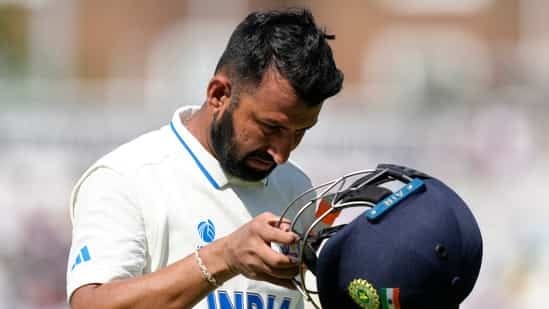Cheteshwar Pujara is still only 35. With sports science, nutrition, and recovery methods so much more advanced than they were three or four decades ago, it’s no longer an age where the selectors’ axe necessarily means the end. But with KL Rahul and Shreyas Iyer due back from injury, and Yashasvi Jaiswal or Ruturaj Gaikwad likely to make good use of their opportunity, the prospects of a return look pretty bleak. It doesn’t help Pujara that he has been a one-format player for years. Outside of Tests, he simply doesn’t play any high-profile games where he could catch the eye enough to influence selection.
So, if this is the end of a Test career that began back in October 2010 – before Virat Kohli, and long before Rohit Sharma and Ajinkya Rahane – how will he be remembered? The timing of his career certainly didn’t help Pujara. While many wondered whether anyone could step into Sachin Tendulkar’s shoes at No. 4, Kohli had the force of personality and a game attractive enough to carve out his own niche. In many ways, Pujara had the far harder task, of succeeding Rahul Dravid.
Dravid wasn’t the run machine that Sir Donald Bradman was. He wasn’t a dominator like Ricky Ponting, or as stylish as Hashim Amla. He wasn’t even as relentlessly consistent as Kumar Sangakkara. But like Kane Williamson, another of the all-time-great No.3s, he became a byword for solidity. He was also the bloke everyone loved, from housewives to ad-campaign managers to the stiff upper lips at Lord’s.
Dravid also had a happy knack of making the big scores when the world was watching, and the page-one headlines were composed. What did some of India’s most famous victories in the 2000s have in common? Kolkata 2001, Headingley 2002, Adelaide 2003, Rawalpindi 2004, Kingston 2006 and Perth 2008 all featured a monumental or significant Dravid innings. Even when the team was tarred and feathered 4-0 in England in 2011, Dravid left with reputation enhanced and praise echoing in his ears, thanks to three magnificent centuries.
And whether you like it or not, cricket history has always been skewed in favour of those who made ‘tough’ runs away from home. If Tendulkar and Kohli are so revered, it’s partly because of their sensational records in Australia. Pujara had one epic tour there, in 2018-19, when he scored three centuries. It was just his luck that India’s historic first series win on Australian soil would be eclipsed within just 24 months, as a side missing Kohli for three Tests and with other stalwarts dropping like flies, managed to overcome a much stronger Australian team than the one India had beaten in 2018-19.
Pujara also never shone in England – whose media still controls much of the cricket narrative – and his one great series in South Africa was a decade ago, when India lost 1-0 over two Tests. That he averaged 52.58 in 51 home Tests, despite playing on some spectacularly bad pitches over the past half-decade, is mostly just brushed off with faint praise.
In some ways, Pujara paid the price for being born in the wrong era and batting at the wrong position. He was neither an enforcer like Viv Richards (12 centuries and an average of 61.54 at No.3) nor a stylist in the Greg Chappell or Zaheer Abbas mould. Off the field too, he was a man of few words, uncomfortable in front of the camera or on social media.
There’s also more than a bit of irony in the fact that Pujara has been discarded even as Dravid and the rest of his staff try to salvage their coaching reputations. Whether it was Ravi Shastri or Anil Kumble, or Dravid himself, they all spoken of how much Pujara was valued in the dressing room and in tough situations. But without the charisma of Rohit, the appeal of Kohli or the leadership nous often shown by Rahane, he was always the most expendable.
Any way you slice and dice it, he has had a superb career. You don’t turn up your nose at 7,195 runs, 19 centuries and an average of 43.60. But if this is the last we see of Pujara in Test cricket, he leaves behind a trail of regret. A splendid career, but not quite a legendary one. Dravid’s successor in so many ways, but not quite his equal in the marquee games.
Those that will celebrate his removal from the squad had better hope that whoever comes in his stead shows the same courage that Pujara did on his epic tour of Australia. As much as the fours he hit were the blows he wore, on helmet, chest, hips and arms. Like the Tin Soldier in the old kids’ tale, Pujara would not be knocked down. Someday, we’ll recognise the greatness in that.




